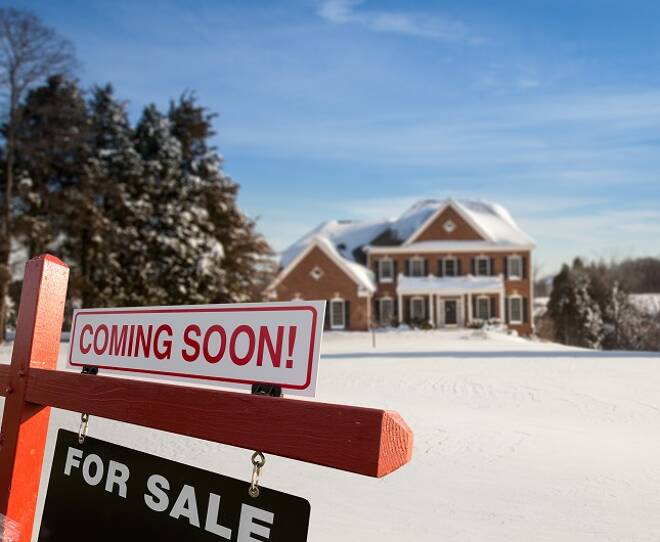Advertisement
Advertisement
U.S Mortgages – Rate Rises Hit Refinance Applications
By:
Mortgage rates were on the rise again to pin back refinance applications and overall loan sizes. Purchasing activity hit a 9-year high.
Mortgage rates were on the rise in the week ending 18th April. 30-year fixed rates rose by 5 basis points following on from a 4 basis point rise from the previous week. The 5 basis point rise took 30-year rates to 4.17% according to figures released by Freddie Mac.
Following the weekly uptick, 30-year fixed rates stood 30 basis points below levels from 12-months ago.
More significantly, 30-year fixed rates have fallen by 77 basis points since last November’s most recent peak of 4.94%.
Economic Data from the Week
Economic data released through the last week included NY Empire State Manufacturing Index, industrial production figures and trade data through to Wednesday.
While manufacturing sector activity was on the rise in NY State in April, industrial production unexpectedly hit reverse in March. On the trade front, the U.S trade deficit narrowed from $51.10bn to $49.40bn in February, driven by a pickup in exports.
While the stats provided some direction to U.S Treasury yields, earnings results and economic data out of China was of greater influence.
Concerns over China’s economic outlook eased on Wednesday. Year-on-year, the economy grew by 6.4%, which was at the same pace as in the 4th quarter. Forecasts were for the economy to grow by 6.3%. Whilst growth slowed from 1.5% to 1.4% quarter-on-quarter, industrial production and retail sales impressed. At the end of the quarter, industrial production surged by 8.5%, with retail sales up by 8.7%.
While the economy did see slower growth compared with the previous quarter, progress on trade talks between the U.S and China raised expectations of a near-term rebound.
The better than forecasted data offset the negative market reaction to disappointing earnings results from, both Goldman Sachs and Citigroup in the week.
Freddie Mac Rates
The weekly average rates for new mortgages as of 18th April were quoted by Freddie Mac to be:
- 30-year fixed rates rose 5 basis points to 4.17% in the week. Rates were down from 4.47% from a year ago. The average fee held steady at 0.5 points.
- 15-year fixed rates also rose by 2 basis points to 3.62% in the week. Rates were down from 3.94% from a year ago. The average fee increased from 0.4 points to 0.5 points.
- 5-year fixed rates decreased by 2 basis points to 3.78% in the week. Rates increased by 11 basis points from last year’s 3.67%. The average fee remained fell from 0.4 points to 0.3 points.
According to Freddie Mac, in spite of a 3rd consecutive weekly rise in mortgage rates, purchase activity reached a 9-year high.
Mortgage Bankers’ Association Rates
For the week ending 12th April, rates were quoted to be:
- Average interest rates for 30-year fixed, backed by the FHA, increased from 4.42% to 4.43%. Points increased from 0.48 to 0.56 (incl. origination fee) for 80% LTV loans.
- Average interest rates for 30-year fixed with conforming loan balances increased from 4.40% to 4.44%. Points decreased from 0.47 to 0.42 (incl. origination fee) for 80% LTV loans.
- Average 30-year rates for jumbo loan balances increased from 4.28% to 4.33%. Points decreased from 0.28 to 0.23 (incl. origination fee) for 80% LTV loans.
Weekly figures released by the Mortgage Bankers Association showed that the Market Composite Index, which is a measure of mortgage loan application volume, declined by 3.5% in the week ending 12th April. The pullback came off the back of a 5.6% fall in the week ending 5th April.
The Refinance Index fell by 8% in the week ending 12th April. The slide came off the back of an 11% fall in the week ending 5th April.
The share of refinance mortgages fell from 44.1% to 41.5%, following a decrease from 47.4% to 44.1% in the week prior.
According to the MBA, the refinance mortgage applications and overall loan sizes hit reverse following the uptick in mortgage rates. In spite of the fall in refinance applications, purchase activity remained strong and rising slightly to reach its highest level since April 2010. Purchase activity was more than 7% higher than a year ago and up year-on-year for a 9th consecutive week.
For the week ahead
Economic data in the first half of the week is on the lighter side. Key stats through to Wednesday are limited to existing and new home sales that are due out on Monday and Tuesday respectively.
While the stats are unlikely to have a material influence on yields, any more news on trade talks will impact in the week.
About the Author
Bob Masonauthor
With over 28 years of experience in the financial industry, Bob has worked with various global rating agencies and multinational banks. Currently he is covering currencies, commodities, alternative asset classes and global equities, focusing mostly on European and Asian markets.
Advertisement
